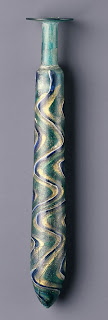From its humble beginnings as a small, dominated city in Italy, Rome rose up to become a symbol of power, stretching across Europe, Asia Minor, and Northern Africa. Influenced by the cultures they communicated with, or overcame, they would "borrow" religion, or arts, philosophical ideas and all other facets of culture, adapting and expanding on them to create a unique culture, and an ever more distinctive Empire.
This image of Jupiter flying through the heavens astride
an eagle was adapted for use in Roman official art to depict scenes of
apotheosis, the act of making a deceased emperor a member of the divine, embodying their descent to heaven. Cameo fragment with Jupiter astride an eagle, 1st century B.C.E. - 1st century C.E. source
Glass mosaic bottle. Striped mosaic pattern formed from a single pre-formed cane comprising lengths arranged in repeated groups of different colors. source
Wall painting fragment from the north wall of Room H of the Villa of P. Fannius Synistor at Boscoreale source
Sandaled foot, Augustan. Piece comes from full statue. Tongue of sandal has Nile characteristics, which suggests either Egyptian divinity of the emperor, triumphant over Egypt.
1st century B.C.E. adaptation of a 3rd century B.C.E. Greek statue. The acclaimed Greek philosopher, Epicuros
Christ before the Elders. Chalcedony, yellowish.
These water spouts would have adorned a public bath in one of the major cities.
Fresco wall painting in a cubiculum (bedroom) from the Villa of P. Fannius Synistor at Boscoreale. This wall painting depicts a statue of Diana Lucina bearing torches, within a larger shrine.
The central figure, Dionysus, seated on a panther, is surrounded by four larger standing figures who
represent the four Seasons (from left to right, Winter, Spring, Summer,
and Fall).
This large group of enamels likely adorned the yoke and
harness of a ceremonial chariot.





















































